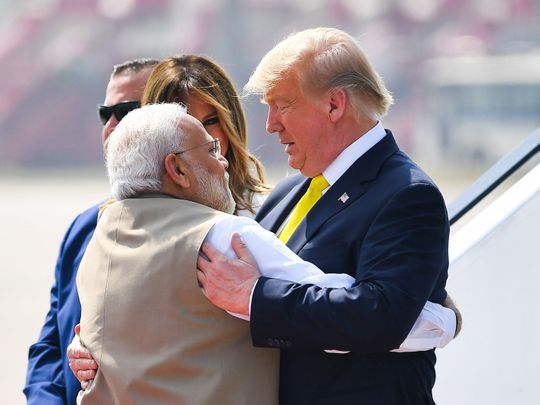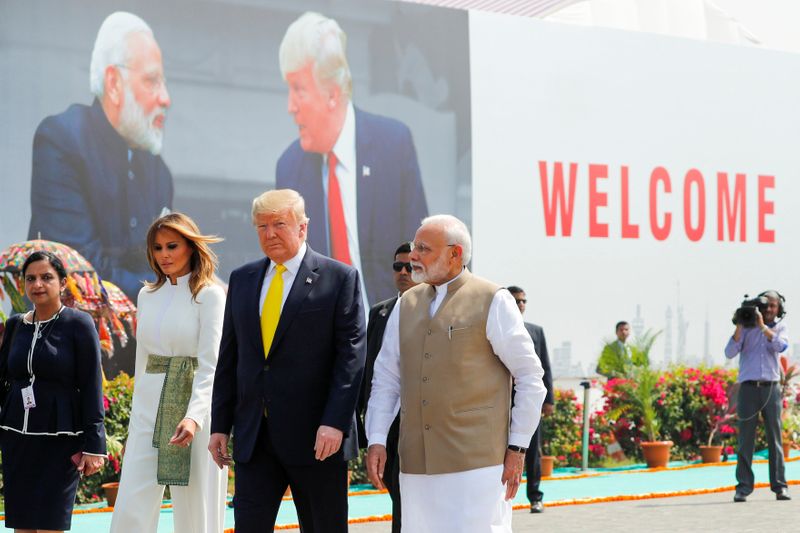
Five years ago, on a cold January afternoon, when then United States president Barack Obama walked into the Ballroom of Hyderabad House in New Delhi along with Indian Prime Minister Narendra Modi, it heralded in many ways a new era.
India-US relations no longer had to be judged through the prism of American one-upmanship or India’s narrative of a more-wronged-than-wrong South Asian power
The world’s oldest democracy, that is America, was perhaps for the first time seen as coming out of the matrix of a transactional relationship with a third-world nation.
And that evening, inside a packed Hyderabad House, when Modi referred to the US president by his first name and not as “Mr President” or “Mr Obama”, it echoed the voice of a new, more confident India that had certainly learnt to come out of a persecution complex and seek a more level-playing field in forging bilateral ties based on mutual trust and respect.
One of the biggest areas of Indo-US cooperation has been in the realm of fighting global terror. Both Washington and New Delhi have struck enough common ground to seek each other’s cooperation in intelligence-sharing and counter-insurgency operations
Actually, the seeds for such a major turnaround in the verve and tenor of Indo-US relations were sown by George W. Bush when he pushed through with the civil nuclear deal with India in 2008. It was Bush who made sure that a reluctant Beijing was on board when the debate came to the crucial stage of a vote at the Nuclear Suppliers Group. Bush, in that sense, was the harbinger of a new, hitherto unheard-of equal-stakes partnership with a developing nation in a post-Cold War era.
But even after admitting Bush Junior’s significant contribution towards presenting a new normal in Indo-US bilateral ties, there can still be no denying that Obama was the first US president in a post-Cold War era who understood and appreciated the importance of a quid pro quo.

Trump handshake
In that sense, what we are seeing now with Donald Trump at the helm is a further consolidation of a relationship that is more symbiotic in nature. India’s large domestic market, the growing clout of Indian-Americans among the business community in the US and the increased confidence in New Delhi’s ability to sustain its role as a counterbalance to Beijing have all made crucial contributions towards India’s emergence as an equal-stakes partner in the eyes of the US in a unipolar world order.
Given such a background, it is quite in the fitness of things that Trump decided to undertake the current tour of India as a stand-alone venture. According to many experts on and observers of Indo-US relations, the process of de-hyphenating India from its other nuclear neighbour in South Asia, namely Pakistan, is being done in no uncertain terms by Trump.
Make no mistake, even if the trade impasse continues, even if there is no immediate relief in the stringent norms for acquiring H1-B visas to the US, the political significance of a Trump stand-alone visit to India in an election year in US has its own global ramifications. The benefits of such overtures may not be visible in the short term, but they definitely have their long-term benefits.
One of the biggest areas of Indo-US cooperation has been in the realm of fighting global terror. Both Washington and New Delhi have struck enough common ground to seek each other’s cooperation in intelligence-sharing and counter-insurgency operations. The size of the Indian domestic market is another aspect that has made Washington understand and acknowledge the need to placate Indian sentiments.
New matrix
However, having said that, what both the leaderships will have to remember is that the concurrent running of an “America first” and a “Make in India” has its pitfalls too. Trump’s hyper-national narrative can never act as a foil to or complement in any way Modi’s muscular brand of nationalism.
These are two leaders who have been playing to their bases quite successfully for quite some time now. Now, you cannot just be promoting an ‘America first’ ideology while at the same time giving ‘Make in India’ a filip.
Much of the current impasse that we see in the realm of tariffs on imports is a result of the core policies of the two leaders, Modi and Trump — both having committed a fair bit of their respective trade and commerce and even foreign policy priorities to a domestic audience that loves a high-decibel, nationalistic interlocutor.
That is the biggest challenge for both Modi and Trump now — they have both played heir cards to the hilt before an audience that loves a certain jingoistic fervour in their leaders.
But jingoism has to make way for hard, pragmatic life choices that enrich and empower cultures and civilisations. Both India and the US have proved it time and again that just as foreign policy isn’t essentially a zero-sum game, similarly, pragmatic and hard choices by leaders have ultimately stood their ground.
By allowing India back into the mainstream of the civil nuclear trade, after years in wilderness following the Pokhran nuclear tests, Bush Junior had rolled the dice on a new matrix that was reaffirmed by Obama. Now it is up to Trump and Modi to take the game to the next level.
More on Trump in India
- Narendra Modi welcomes Donald Trump with signature bear hug: 'Make in India' meets 'Make America Great Again'
- ‘Open mic’ Trump keeps India guessing
- Trump India trip: 36-hour official visit hosted by Indian Prime Minister Narendra Modi
- Analysis: In Trump’s India rally, Modi bets on bolstering his image








